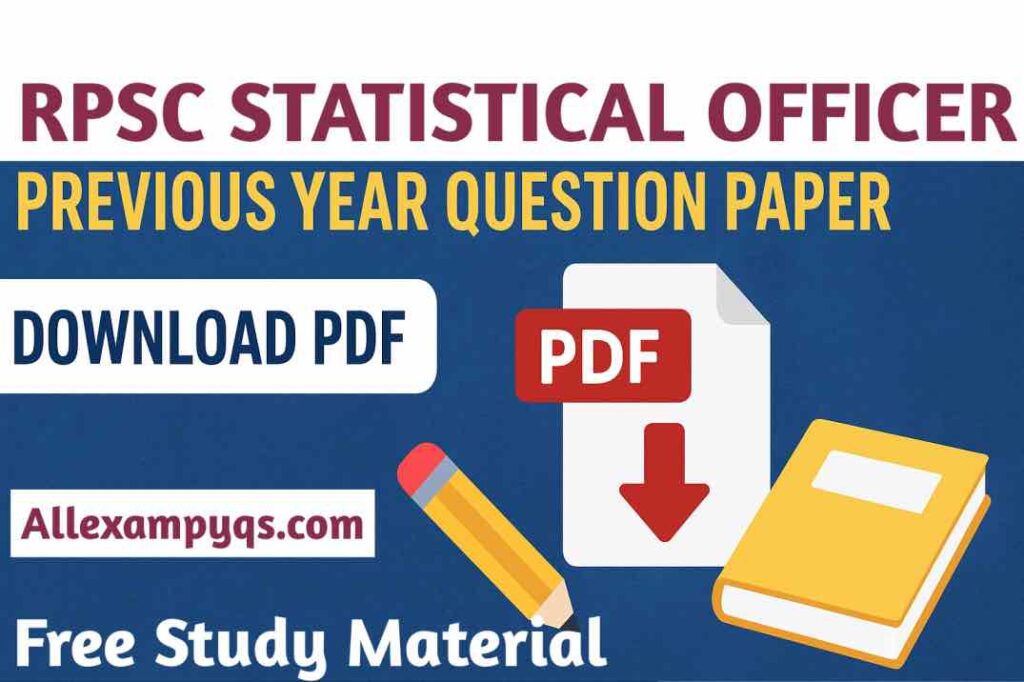📅 Published on: 13.11.2025
Table of Contents
ToggleRPSC Statistical Officer Previous Year Question Paper

The RPSC Statistical Officer Previous Year Question Paper is one of the most powerful tools to prepare effectively for the Rajasthan Public Service Commission (RPSC) Statistical Officer exam. These papers not only show you the exam pattern and question type but also help you understand which topics carry the most weight.
If you are aiming for a career as a Statistical Officer in the Rajasthan government, this guide will help you in every way — from downloading the previous papers to understanding the syllabus, cutoff, and expert-recommended study plan.
RPSC Statistical Officer Exam Pattern
Before you start solving papers, it’s important to understand the exam structure. The RPSC Statistical Officer written test usually consists of objective-type multiple-choice questions divided into two parts.
Exam Highlights:
- Mode of Exam: Offline (OMR based)
- Type of Questions: Multiple Choice (MCQ)
- Total Marks: 150
- Total Questions: 150
- Duration: 2 Hours 30 Minutes
- Negative Marking: ⅓ mark for every wrong answer
- Medium: Hindi and English
Subject-wise Weightage:
Part | Subject | No. of Questions | Marks |
Part A | General Knowledge of Rajasthan | 40 | 40 |
Part B | Statistics / Economics / Mathematics | 110 | 110 |
Total | 150 | 150 |
RPSC Statistical Officer Previous Year Question Paper – Download PDF
Practicing from past papers is like rehearsing for the real exam. Here are the available PDFs and sources where you can download them easily.
RPSC Assistance Statistical Officer Previous Year Question Paper – Download PDF
Year | Download Link |
2023 | RPSC Official Site – Assistant Statistical Officer Exam 2023 PDF |
2021 | |
2018 |
See More…
RPSC Statistical Officer Cut Off (Last Year)
Cutoff marks act as a performance benchmark. They help you estimate how many marks are needed to secure a place in the merit list.
Below are the official cutoff marks for the RPSC Statistical Officer 2023 exam:
Category | Cutoff Marks |
General (Male) | 86.62 |
General (Female) | 78.41 |
OBC | 79.23 |
SC | 71.83 |
ST | 65.85 |
Detailed RPSC Statistical Officer Syllabus
The syllabus for the RPSC Statistical Officer exam is divided into two parts — General Knowledge of Rajasthan and Statistics/Economics/Mathematics.
Part A – General Knowledge of Rajasthan
- History, Art & Culture of Rajasthan
- Geography of Rajasthan
- Political and Administrative Structure
- Economic Development and Resources
- Major Current Affairs of the State
Part B – Statistics / Economics / Mathematics
- Descriptive Statistics: Mean, Median, Mode, Variance, Standard Deviation
- Probability Theory: Random Variables, Distributions, Sampling
- Statistical Inference: Estimation, Hypothesis Testing, Correlation, Regression
- Applied Statistics: Time Series, Index Numbers, Survey Methods
- Economics: Micro & Macro Economics, National Income, Economic Planning, Inflation
- Mathematics: Algebra, Calculus, Matrices, Determinants, Linear Equations
- Official Statistics: Census, Surveys, and Government Statistical Systems
This syllabus aligns closely with postgraduate-level concepts in Statistics or Economics, so focus on clarity and conceptual understanding.
Preparation Tips by Experts
Here’s what toppers and subject experts recommend for aspirants preparing with the RPSC Statistical Officer Previous Year Question Paper:
1. Start with the Syllabus
Before you begin your preparation, thoroughly go through the complete syllabus and understand what each topic demands. Divide your syllabus into weekly study targets — for example, dedicate one week to “Descriptive Statistics” and another to “Probability & Inference.” Cover high-weightage chapters first since they form the backbone of the paper. This structured approach ensures that you finish your syllabus on time without feeling overloaded.
2. Analyze Previous Year Papers
Go through at least 5–6 years of RPSC Statistical Officer previous year question papers and note down the topics that appear frequently. For instance, questions on hypothesis testing or index numbers are often repeated, while some GK topics from Rajasthan history reappear in different forms. This analysis helps you focus on areas that are truly important rather than wasting time on rarely asked concepts.
3. Strengthen Conceptual Clarity
Don’t just memorize formulas — understand where and how they are applied. For example, instead of just learning the formula for correlation, practice interpreting correlation results from data sets. RPSC exams often include application-based questions, so a conceptually strong foundation will help you solve tricky numerical and reasoning problems accurately under time pressure.
4. Create Short Notes
Prepare concise notes of formulas, definitions, and Rajasthan GK facts while studying. Keep them handy for daily revision during the last few weeks. For example, make a one-page summary of all statistical tests — z-test, t-test, chi-square, etc. Similarly, jot down key Rajasthan historical dates or geography facts. These short notes will become your most valuable revision tool before the exam.
5. Mock Tests and Time Practice
Once you complete a section, take mock tests in a real exam-like environment of 2.5 hours. Track your performance — how many questions you attempt, how many are correct, and how much time each part takes. For instance, if you take too long in the GK section, adjust your strategy to save time for numerical questions. Regular mock tests improve both speed and accuracy — two crucial aspects for clearing RPSC exams.
6. Balance Rajasthan GK and Core Subjects
Many candidates focus only on Statistics or Economics, but Rajasthan GK carries 40 marks and can be a game-changer. Dedicate at least one hour daily to study Rajasthan’s culture, geography, and economy. For example, learning about Rajasthan’s water resources or major industries can help you score easy marks. A balanced approach ensures that no section pulls down your overall score.
7. Revise Using Question Papers
In the last month before the exam, solve one full RPSC Statistical Officer previous year question paper every alternate day. This practice not only improves your speed but also helps you identify weak areas quickly. For example, if you consistently make mistakes in probability distributions, revise that topic again. Treat these papers like full-fledged mock exams — time yourself strictly and analyze every mistake.
8. Stay Updated
Always check the official RPSC website (rpsc.rajasthan.gov.in) for any changes in the syllabus, exam date, or notification updates. Many aspirants miss important updates and lose valuable preparation time. Staying informed helps you align your study plan with the latest pattern and ensures you never miss deadlines for form submission or admit card download.
Conclusion
The RPSC Statistical Officer Previous Year Question Paper is not just a practice tool — it’s a complete guide to understand the exam inside out. Combine it with a solid grasp of the syllabus, consistent practice, and smart time management, and you’ll be well-prepared to clear the RPSC Statistical Officer exam with flying colors.
Remember, success in such competitive exams is built through discipline, analysis, and consistency.
FAQs
How many questions are there in the RPSC Statistical Officer exam?
There are 150 objective-type questions carrying a total of 150 marks.
Is there negative marking in the exam?
Yes, one-third mark (0.33) is deducted for each wrong answer.
What is the cutoff for the RPSC Statistical Officer 2023?
For the General category, it was around 86.62 marks.
How can previous year question papers help in preparation?
They help you understand the exam structure, frequently asked topics, and real difficulty level, which makes your preparation more focused.

